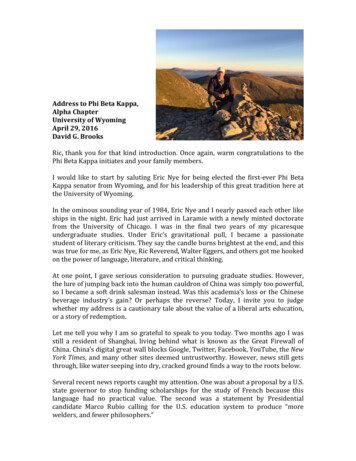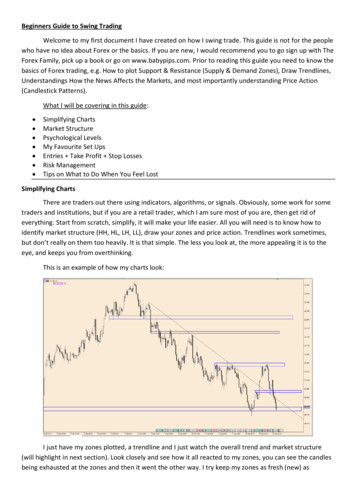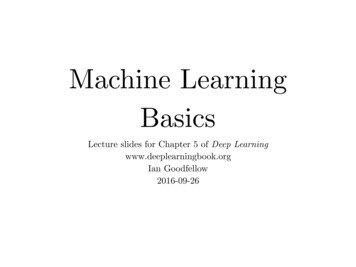
Transcription
SRCs and Double Beta DecaySaori Pastore2nd Workshop on Quantitative Challenges in SRC and EMC ResearchMIT March 2019blaCarlson & Gandolfi (LANL)Schiavilla (ODU JLab) & Baroni (USC) & Piarulli (WashU) & Wiringa (ANL)Mereghetti & Cirigliano & Graesser (LANL)& Dekens (UCSD) & de Vries (Nikhef) & van Kolck (AU CNRS/IN2P3)1 / 23
Towards a coherent and unified picture of neutrino-nucleus interactions*ω*ω*ω*ω few MeV, q 0: β -decay, β β -decays few MeV, q 102 MeV: Neutrinoless β β -decays. tens MeV: Nuclear Rates for Astrophysics 102 MeV: Accelerator neutrinos, ν -nucleus scattering2 / 23
Nuclear InteractionsThe nucleus is made of A non-relativistic interacting nucleons and its energy isAH T V ti υij i 1i jVijk .i j kwhere υij and Vijk are two- and three-nucleon operators based on EXPT data fittingand fitted parameters subsume underlying QCDπππ* QMC: AV18 UIX / AV18 IL7Wiringa Schiavilla Pieper et al.* QMC: NN(N2LO) 3N(N2LO) (π &N)Gerzelis Tews Epelbaum Gandolfi Lynn et al.* QMC: NN(N3LO) 3N(N2LO) (π &N& )Piarulli et al.Piarulli et al. - PRL120(2018)0525033 / 23
Nuclear Currents1b2bℓ′Aℓ′ρ i 1qq ρi ρij . ,i jAjℓℓ ji jij .i 1i j* Nuclear currents given by the sum of p’s and n’s currents, one-body currents (1b) pL pS nS* Two-body currents (2b) essential to satisfy current conservation* We use Meson-Exchange Currents (MEC) or χ EFT Currents .qγN q·j [ H, ρ ] ti υij Vijk , ρN4 / 23
EM Moments, EM Decays and e-scattering off nuclei9Be(5/ 2 3/2-) B(E2)9Be(5/ 2 3/2-) B(M1) 48B(3 2 ) B(M1)38B(1 2 ) B(M1)8Li(3 2 ) B(M1)8Li(1 p7Li3H29B9Liµ (µN)6Li*10B12H0-1GFMC(1b)GFMC(1b 2b)EXPTn8Li 8B6Li10B*7Be9Be 9C2 )B(M1)7Be(1/ 2 3/2-) B(M1)7Li(1/ 2 3/2-) B(E2)7Li(1/ 2 3/2-) B(M1) 3He-26Li(0 -3EXPT0GFMC(1b) 1 ) B(M1) GFMC(1b 2b)12Ratio to experimentPastore et al. PRC87(2013)035503 3 Lovato et al. PRC91(2015)062501Electromagnetic data are explained whentwo-body correlations and currents are accounted for!5 / 23
Single Beta Decay Matrix Elements in A 6–10107763Ratio to EXPT1CBeBeHeH107763BLi(ex)Li(gs)LiHegfmc 1bgfmc 1b 2b(N4LO)Chou et al. 1993 - Shell Model - 1b1.11.2gfmc (1b) and gfmc (1b 2b); shell model (1b)Pastore et al. PRC97(2018)022501A. Baroni et al. PRC93(2016)015501 & PRC94(2016)024003Based on gA 1.27 no quenching factorGT in 3 H is fitted to expt - 2b give a 2% additive contribution to 1b prediction* similar results were obtained with MEC currents data from TUNL, Suzuki et al. PRC67(2003)044302, Chou et al. PRC47(1993)1636 / 23
Neutrinoless Double Beta Decaye e gAνgA“The average momentum is about 100 MeV, a scale set by the average distancebetween the two decaying neutrons” cit. Engel&Menéndez* Decay rate (nuclear matrix elements) 2 hmβ β i2 *7 / 23
Neutrinoless Double Beta Decay: STATUS8R-EDF76NR-EDFQRPA TuQRPA JyM0νββ5IBM-2SM Mi4SM St-Md Tk32104876 8296 100116 124 130 136150AJavier Menéndez - arXiv:1703.08921 (2017)8 / 23
Double beta-decay transition operatorsνπυν υππ υπ υNN ππNNσ1 · σ2 · · · υν N2LO loopmπ q 2σ1 · q σ2 · qLππ τ1, τ2, mπ (q2 mπ2 )2σ1 · q σ2 · qLπ τ1, τ2, 3 2mπ (q m2π )σ ·σLNN τ1, τ2, 1 3 2mπLν τ1, τ2, Lππ , Lπ , LNN encode hadronic and model dependent particle physics* Cirigliano & Dekens & Mereghetti & Walker-Loud PRC97(2018)065501Leading order operators are two-body operatorsUnderstanding two-body physics, (correlation and currents) is crucialIN COLLABORATION WITHEmanuele Mereghetti & Wouter Dekens & Cirigliano & Carlson & WiringaPRC97(2018)0146069 / 23
Double beta-decay Matrix Elementsin A 6, T 0 and A 12, T T-πN12C0.6-1C(r) [fm ]0.40.20-0.2-0.4-0.6-0.8024602r [fm]ν46r [fm]πππNNPRC97(2018)01460610 / 23
Momentum .4 10-32.0 10-31.6 10C(q) [MeV ]-3-11.2 10-48.0 10-44.0 100.0-4-4.0 10-4-8.0 10-3-1.2 100200400q [MeV]600 0200400q [MeV]600* Peaks at 200 MeV* A 10 highly suppressed w.r.t. A 12 (cluster structure matters?)* A 12 ‘most similar’ to experimental casesPRC97(2018)01460611 / 23
Sensitivity to ‘pion-exchange-like’ correlations100.410HeGT-AA with correlationsGT-AA without correlationsBe-32 10-32 100.30.1-44 10-1-1C(r) [fm ]-48 10C(q) [MeV ]-31 100.200-4-4 10-0.10246 0200r [fm]400q [MeV]600* no ‘pion-exchange-like’ correlations* yes ‘pion-exchange-like’ correlationsPRC97(2018)01460612 / 23
Comparison with calculations of larger nucleiFν- 1/4 FNNFNN GTAA GTν GTππ GTπN0-1GTππGTπN11NormA 10A 12A 48 JMA 76 JMA 76 JHA 136 JMA 136 JH0NormA 10A 12A 48 JMA 76 JMA 76 JHA 136 JMA 136 JH-1JM Javier Menendez private communicationJH Hyvärien et al. PRC91(2015)024613* Relative size of the matrix elements is approximately the same in all nuclei* Short-range terms approximately the same in all nucleiPRC97(2018)01460613 / 23
Inclusive (e , ν ) scattering* inclusive xsecs *d2 σ σM [vL RL (q, ω ) vT RT (q, ω )]dE′dΩe ′ Rα (q, ω ) δ ω E0 Ef h f Oα (q) 0i 2fLongitudinal response induced by OL ρTransverse response induced by OT j. 5 nuclear responses in ν -scattering.1b2bℓ′Aρ ρi ρij . ,i 1ℓ′i jAqqℓℓj ji jij .i 1i jq · j [ H, ρ ] [ti υij Vijk , ρ ]14 / 23
Lessons learned from exact calculations and electromagnetic dataLongitudinal and transverse responses of 12 C31 body(1 2) q(MeV/c)700800Carlson et al. PRC65(2002)024002Benhar, Day, Sick Rev.Mod.Phys.80(2008)198, data Finn 1984ST (q)†hj1b j1bi 0†hj1b j2b vπ i hvπ2 i 0 h0 j† j 0i h0 j1b † j1b 0i h0 j1b † j2b 0i . . . j j1b j2bThe enhancement of the transverse response is dueto interference between 1b and 2b currents ANDpresence of two-nucleon correlations two-body physics essential to explain the data 15 / 23
Factorization R(q, ω ) δ ω E0 Ef h 0 O† (q) f ih f O(q) 0 ifR(q, ω ) Zdth 0 O† (q) ei(H ω )t O(q) 0 iAt short time, expand P(t) ei(H ω )t and keep up to 2b-termsH ti υijii jandO†i P(t)Oi O†i P(t)Oj O†i P(t)Oij Oij† P(t)Oij1b2bℓ′ℓ′qqℓℓ16 / 23
Factorization up to two-body operators: The Short-Time Approximation (STA)ℓ′ f Response functions are given by the scattering offqpairs of fully interacting nucleons that propagate into a correlated pairℓof nucleonsR(q, ω ) † δ (ω E0 Ef ) h 0 O (q) f ih f O(q) 0 ifO(q) O(1) (q) O(2) (q) 1b 2b f i ψp′ ,P′ ,J,M,L,S,T,MT (r, R)i correlated two nucleon w.f.* We retain two-body physics consistently in the nuclear interactions and electroweak currents* STA can describe pion-production induced by e and ν* Definition: Response Density D *R(q, ω ) Z Z δ (ω E0 Ef ) dΩP′ dΩp′ dP′ dp′ p2′ P2′ h 0 O† (q) p′ , P′ ih p′ , P′ O(q) 0 iδ (ω E0 Ef ) dP′ dp′ D(p′ , P′ ; q)D(p′ , P′ ; q) has info on the nucleus soon after the probe interacts with the pair of nucleons;provides more “exclusive” info in terms of nucleon-pair kinematics;correctly accounts for interference terms17 / 23
Short-Time Approximation: Response DensitiesTransverse “response-density” 1b 2b for 4 HeD(p′ , P′ ; q)* Preliminary results *18 / 23
STA Transverse Responseq 300 MeVPlane Wave Propagator vs Correlated Propagator0.016plane wavescorrelated propagator0.014transverse response 300omega MeVRα (q, ω ) Z δ (ω E0 Ef ) dΩP dΩp dP dp p2 P2 h 0 O†α (q) p, Pih p, P Oα (q) 0 i* Preliminary results *19 / 23
Short-Time Approximation: back to back scatteringJLab, Subedi et al. Science320(2008)14752500back 2 back totback 2 back off pp pairs2000S(e,E) Transverse150010005000-5000100200300400500relative energy of the pair e MeVq 500 MeV, E 65 MeV pp vs tot Also relevant to semi-inclusive processes * Preliminary results *20 / 23
Short-Time Approximation: back to back scatteringBack to Back Scattering of pp vs NNBack to Back Scattering of pp vs NN1b 1b*2b (pp)1b (pp)1b 1b*2b 2b (full)1b (full)1b*2b 2b (full)1b 1b*2b 2b (full)20001500250020001500Total energy of the pair E 65 MeV10001000External mometum q 500 MeV5005000002004008006002500Transverse Response DensityTransverse Response Density25001b (full)1b*2b 2b (full)1b 1b*2b 2b (full)1b (pp)1b*2b 2b (pp)1b 1b*2b 2b (pp)20001500250020001500Total energy of the pair E 145 MeV1000External mometum q 700 MeV500010005000200Relative energy of the pair e [MeV]4006008000Relative energy of the pair e [MeV]ji jj 1bji jij jij jij 1b*2b 2bjtot jtotsolid lines all pairsdashed lines proton-proton pairs* Preliminary results *21 / 23
Short-Time Approximation: Comparison with data and exact calculations64HeWorld’s dataLIT, Bacca et al. (2009)GFMC, Lovato et al. (2015)STA, Pastore et al. PRELIMINARYPWIAAV18 UIX4-1-3RL [MeV 10 ]532100100200300ω [MeV]400500Longitudinal Response function at q 500 MeV* Preliminary results *22 / 23
Short-Time Approximation: Summary1b2bℓ′ℓ′qqℓℓWhat it is* It is based on factorization at short-time* Retains two-body operators correlating nucleon-pairs and associated two-body currents* Describes the scattering of leptons off pairs of fully interacting nucleons* Lepton-nucleus interaction occurs via 1b and 2b currents and ensuing interference terms* It provides response functions* It provides response densities as function of the relative and total energy of a nucleon-pair* It can accommodate for semi-inclusive processes, pion-production, relativity* It can be implemented in AFDMC to study A 40 systemsWhere we are* Electromagnetic Response Functions and Densities of 4 He, 3 H and 3 He are available for values of q andE 800 MeVWork in progress* Implementation of axial currents into VMC codes* Implementation of the STA into VMC codes for 12 C23 / 23
Towards a coherent and unified picture of neutrino-nucleusinteractions * ω few MeV, q 0: β-decay, ββ-decays * ω few MeV, q 102 MeV: Neutrinoless ββ-decays * ω.tens MeV: Nuclear Rates for Astrophysics * ω 10










